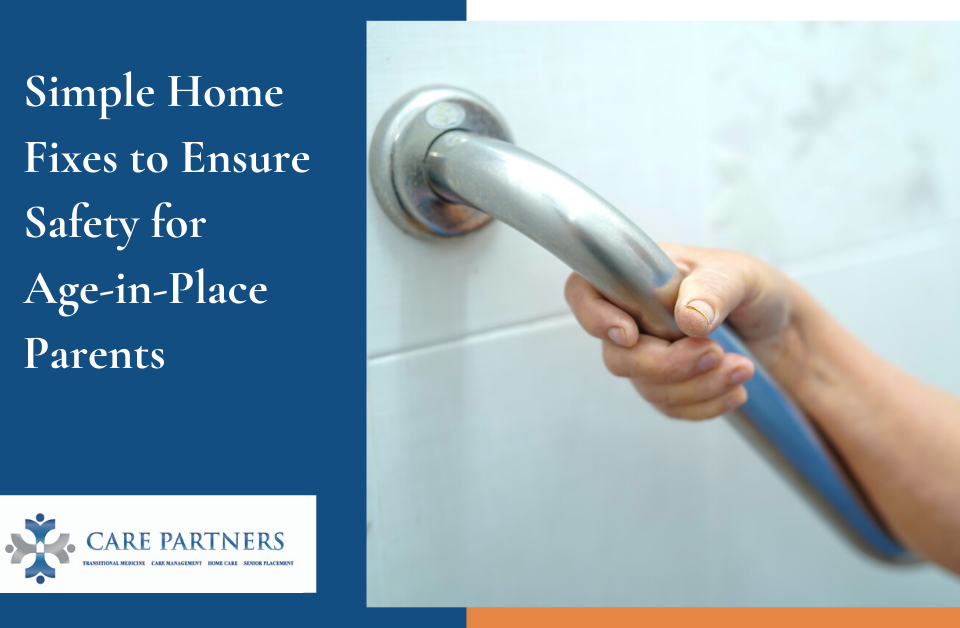Simple Home Fixes to Ensure Elderly Safety For Age-in-Place Parents

Elderly safety is a top issue if your aging loved one decides to continue living at home. Stairs, tight doorways, slippery areas, and limited space for wheelchairs can make staying at home a challenge.
If the elder care option you choose for your parents is aging in place, you may need to make some upgrades to make the home safe.
Some updates are relatively easy and involve simple additions, while others require complete renovations to fit accessibility and safety needs. Consider the scope of the fixes necessary as well as the benefits of home care and letting your parent age in place to help you decide if the cost is worth it.
Keep reading to learn about some of the common modifications made to homes to improve elderly safety.
Grab Bars in the Bathroom
The bathroom is a particularly dangerous place with a high risk of falls. It can be challenging for seniors to get up and down from the toilet or to access the shower.
Grab bars offer support for all types of bathroom activities. Install grab bars on the wall near the toilet and shower. You can also install them in the shower along with a shower seat for seated cleaning.
Walk-In Tub or Shower
Another cause of falls in the bathroom is getting into or out of the tub. Stepping over the side of the tub can become more difficult with age.
A walk-in tub or shower eliminates that tripping hazard. Make it even safer with non-slip floor surfaces in the shower and the bathroom.
Main Floor Bedroom and Bathroom
If your elderly parent lives in a two-story home, a main floor bedroom and bathroom is something you may need. Climbing stairs can be difficult or impossible, depending on your parents’ mobility.
Even if your parents can still handle stairs, going up and down them increases the risk for a serious fall. Limiting how much they climb the stairs keeps them safer.
Consider turning a first-floor room, such as a den, into a bedroom. Adding onto the main floor to create a bedroom is another option, but it can be costly. The average room addition runs $44,338 with a typical range between $20,884 and $67,803.
If it’s not possible to create a bedroom on the main floor, you may be able to install a stairlift in the home to let your elderly parents reach the top floor safely.
Adding a bathroom to the main floor requires extensive plumbing work, which also adds to the overall renovation budget.
Exterior Ramp
Stairs on the exterior to get into the home present a tripping hazard for seniors. If your parent uses a wheelchair, stairs make it very difficult to get inside the home. If you live in an area with snow or lots of rain, the stairs can become dangerously slippery in bad weather.
Adding a ramp to the front entrance cuts down on the tripping hazards. It also makes it possible to roll a wheelchair into the home easily.
Wider Door Frames
If your parent uses a wheelchair, you may need to widen the doorways in the home. A wheelchair needs at least 32 inches of clearance for a straight approach through a doorway. If you need to turn a corner to enter the room, a wider space at least 36 inches may be necessary to make it through the door.
Bathroom doors are often narrow. Other interior doors may also be less than the 32-inch width. Consider widening the doorways if your parent is in a wheelchair to ensure access to all rooms.
Replacing regular doors with pocket doors can make it easier to get wheelchairs through them. Traditional hinged doors stick out into the doorway, which may cause wheelchairs to get caught on the doors.
Pocket doors slide entirely into the wall when opened. This gives you access to the full door opening and keeps the door from sticking out and catching the wheelchair.
Lever Door Handles
Turning a doorknob seems simple enough, but it can be challenging if you have limited mobility in your hands or a painful condition, such as arthritis. A senior may have difficulty grabbing and turning traditional knobs, which could leave them stuck outdoors or in a room until help arrives.
Lever-style door handles are much easier to manipulate. You can push down on the lever without tightly grasping it to open the door. Replace the interior and exterior doorknobs with levers to ensure your elderly parent has full access to all areas of the house.
Increased Lighting
As people age, they need more light to see well. Adding more lighting to the home can improve safety by helping seniors see potential hazards better. This is especially true in areas such as the kitchen and areas with stairs, where the risk of injury is higher.
Slip-Resistant Flooring
Every year, 3 million people 65 and older end up at the ER for falls. Broken bones, head injuries, and other serious injuries happen in one out of five falls. Once you fall, you have double the chance of falling again.
Doing everything you can to prevent slips and falls helps your elderly loved one stay out of those statistics. If the home has slippery floor surfaces, replace them with something that has more traction.
Carpet is a good option for most floors and stairs. If you have area rugs on hard-surface floors, add a non-slip rug pad underneath to keep it from sliding.
Raised transitions between flooring surfaces create a tripping hazard. When possible, use a consistent floor covering that’s all one level throughout the home to eliminate those transitions.
Improve Elderly Safety
Aging in place is the most comfortable option for many seniors, but physical limitations may cause their existing homes to become dangerous. Making a few changes can improve elderly safety so your senior loved one can stay at home for longer.
Once you get the safety updates made, check into our home care services to make your loved one’s life easier. From companionship and housekeeping to transportation and errands, we can provide the support necessary for your loved one to continue living at home.


